THE OUTLAW OCEAN PROJECT (PART TWO)
China’s squid ships muscle in on South American waters in bid to become seafood superpower

In recent decades, working aggressively to expand its might, China has transformed itself into the world’s seafood superpower. This pre-eminence has come at a grave human and environmental cost. In Part Two of this series: At sea and on land, China looms large in South America.
Aboard the Modoc on the South Pacific – In 2016, an Argentinian Coast Guard patrol ship shot and sank a Chinese squid ship, the Lu Yan Yuan Yu 010, that allegedly had been fishing illegally in its waters.
In 2019, the Argentinian Navy opened fire on another Chinese squid ship, the Hua Xiang 801, after warning it repeatedly to exit its national waters. In response, the Chinese crew tried to ram the patrol boat and then escaped into international waters.
In 2022, the US Coast Guard cutter James approached a fleet of Chinese fishing ships in international waters off the coast of the Galapagos Islands, which form part of Ecuador, to inspect for illegal fishing. As it did, one of the ships turned aggressively towards the cutter and tried to ram it. After the James took evasive action, the ships sped away.
In recent decades, China’s fishing fleet has moved significantly into the waters off South America, where its aggressiveness, specifically in fishing for squid, has often led to such clashes.
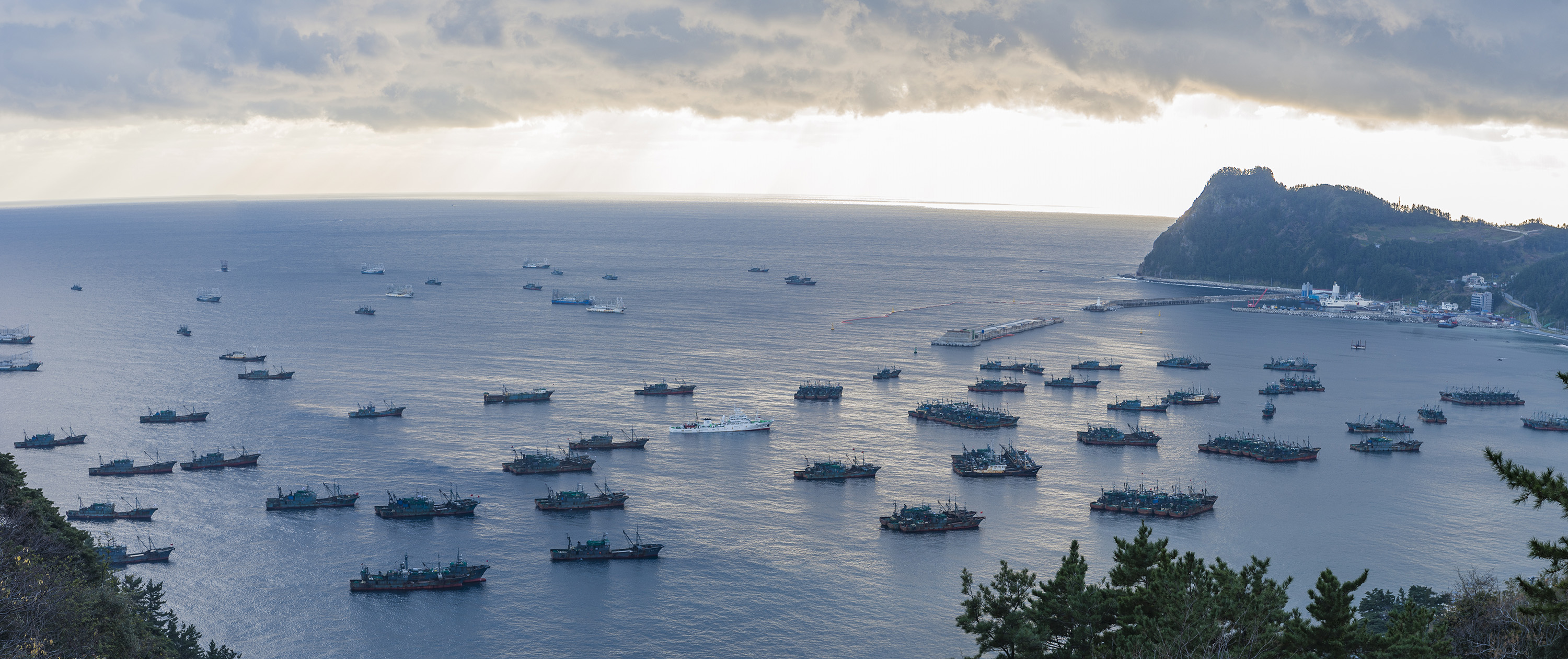
An armada of more than 200 Chinese squid boats flock to the bay of Ulleung Island, South Korea, to ride out a storm. May 2019 (Photo: The Outlaw Ocean Project / Fábio Nascimento)
The move is part of a larger – and successful – effort on China’s part to transform itself into the world’s seafood superpower. More than 300 Chinese squid ships, part of a fleet far bigger than any other in the world, now routinely ride the line of national waters on both sides of the continent. Off the coast of Argentina, local naval authorities have, since 2010, chased at least 11 Chinese squid vessels for suspected illegal fishing in national waters, according to the government, and have sunk at least one.
Read Part One: Death on the high seas — China, the seafood superpower, and the tragic story of Daniel
The tension is complicated by massive investments that China has been making in South American infrastructure. China is the largest foreign financier of infrastructure development on the continent, where it has cornered the market on many road, pipeline, power-plant and port projects, buying itself enormous political goodwill in the process.
American naval analysts and ocean conservationists worry that China is not only developing a stranglehold on the global supply of seafood but also expanding its maritime reach and political influence into the US’s own backyard.
The hard cash that Beijing is injecting into many of those countries’ economies is a key part of its so-called Belt and Road Initiative, which the Chinese government describes as an ambitious economic agenda aimed at building goodwill abroad, boosting economic cooperation and providing otherwise inaccessible development funding to poorer nations.
In South America, that money serves in many ways as China’s hedge against the hostility that its aggressive fishing practices have engendered in the region. Several South American countries have recently imposed their own rules on the Chinese and other foreign fleets that use their ports or fish in their waters, but China’s presence and influence in the region is clearly on the rise.
Whitley Saumweber, a professor of marine affairs at the University of Rhode Island, said that this concerns American naval analysts and ocean conservationists alike, who worry that China is not only developing a stranglehold on the global supply of seafood but also expanding its maritime reach and political influence into the US’s own backyard.
The consequences, he said, include the erosion of US power, the destabilisation of global food security, the undermining of international law, and, in some regions, the heightening of military tensions. These concerns come against the backdrop of an escalating US trade war with China, brewing espionage tensions, and competing loyalties in the Russia-Ukraine war.

On 22 March 2019, several thousand protesters marched along Avenida 18 de Julio in Montevideo, Uruguay, in opposition to a Chinese ‘mega-port’ project. 22 March 2019 (Photo: Milko Schvartzman)
When Chinese squid ships target the high seas of the Pacific Ocean and need access to ports on the western side of South America, they have historically looked to Peru. One regional trade group estimated that between 2015 and 2019, nearly 900 visits by Chinese ships visited Peru’s Callao and Chimbote ports. In 2020, in an effort to prevent its ports from facilitating illicit activity, Peru began requiring all ships entering its waters to transmit to port officials locational data showing their whereabouts during the preceding six months, so that authorities can verify that they have not engaged in illegal activity. “The Chinese were not happy at all,” said Alfonso Miranda, the director of Calamasur, a squid trade group in the region.
After the new rule took effect, only 36 foreign ships entered Peruvian ports in 2020 and fewer than 10 in 2021, mostly due to emergencies, which, Miranda said, included dropping off dead or sick crew. Most of the Chinese fleet now stay on the high seas, transferring their catch at sea to “trans-shipment” vessels that then carry it directly back to China, and paying service ships to come out to international waters to help with maintenance, refuelling and other operational needs.
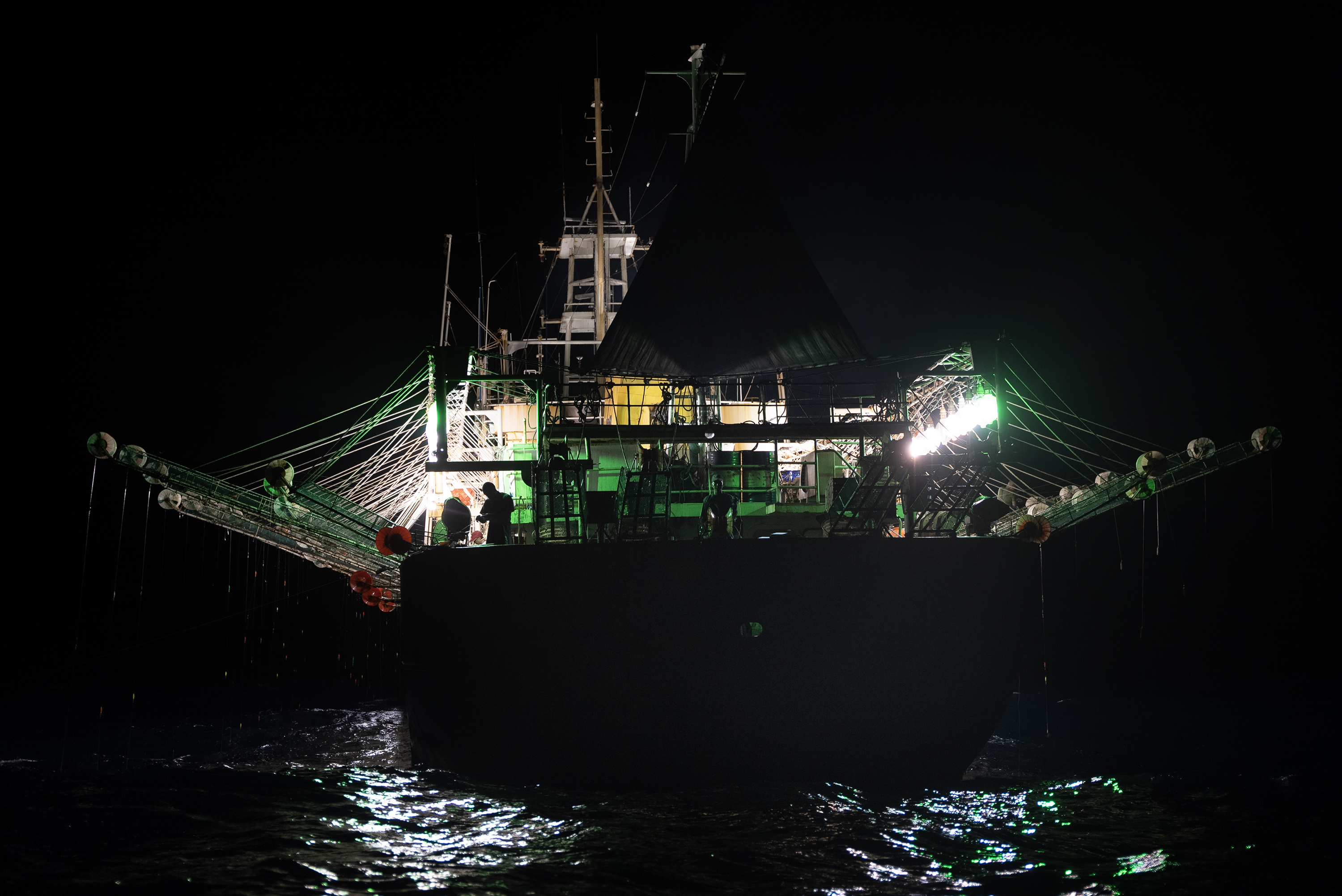
Part of the biggest fleet in the world, more than 300 Chinese squid ships ride the line of national waters on both sides of South America. 9 July 2022 (Photo: The Outlaw Ocean Project/ Ed Ou)
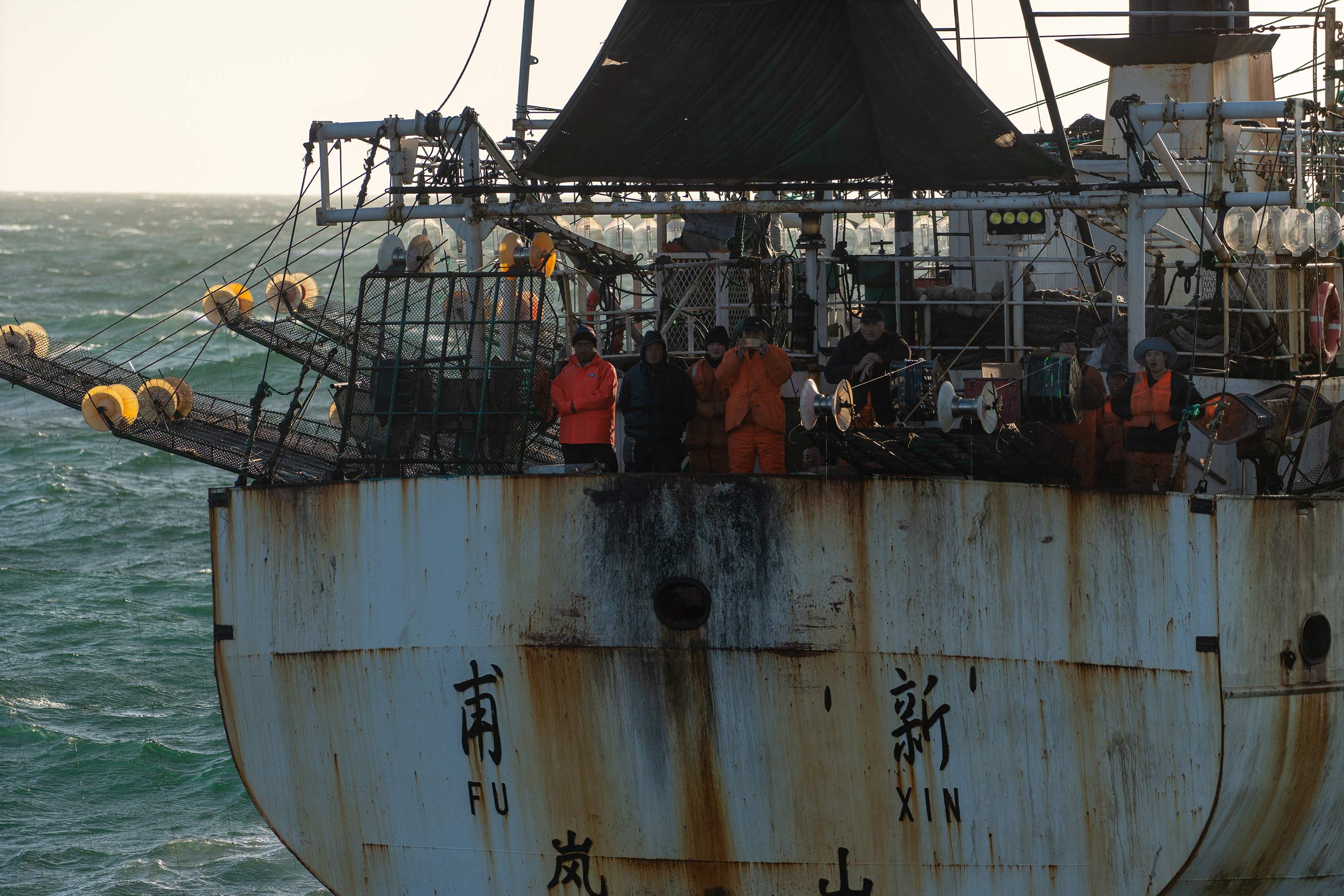
China has transformed itself in recent decades into a seafood superpower, and as part of that effort it has moved significantly into South American waters. 27 February 2022 (Photo: The Outlaw Ocean Project/ Ed Ou)
When Uruguay tried to impose similar limits on China, in 2017, the Chinese got creative: A year later, a Chinese company called Shandong Baoma Fishery Group bought a 70-acre plot of land and began developing plans to build a $210-million “mega-port” in Montevideo, consisting of two main docks, each about 800m long and about 60m wide, with berths for at least 500 ships. Meant to handle 253,000 tonnes of seafood per year, the port was to include a tax-exempt “free-trade zone”, a new ice factory, a shipyard, a refuelling station, business offices, an area to stack shipping containers, and dorms and dining centres for staff.
‘So much money on the table’
The project was to be one of the first times a Chinese company would invest directly in Uruguayan infrastructure, a goal that the local press said the federal government had been pursuing for years. “Dozens and dozens of jobs,” said Juan José Domínguez, who at the time was vice-president of the National Ports Administration, as he cited the benefits of the plan. Uruguay’s then-president, Tabaré Vázquez, was so enthusiastic about the project that he attempted an end-run around the constitution, which required a two-thirds majority approval vote by the general assembly to build a new port in the country – a supermajority that the ruling party had not assembled.
On 11 February 2019, Vázquez issued a presidential decree expanding by several kilometres the area covered by the existing port, to incorporate the area of new construction. “There’s so much money on the table that politicians start bending the law to grab at it,” said Milko Schvartzman, a marine researcher based in Argentina.
On 22 March, an opposition movement organised a protest against the proposed port, during which several thousand protesters marched along Avenida 18 de Julio, a thoroughfare commemorating the birthdate of Uruguay’s first constitution.
Two months later, the Chinese announced that they were cancelling the project – but continued cultivating their relationship with Uruguay, as they have done with other Latin American countries with ports used by Chinese fishing vessels.
During the pandemic, for example, China supplied Uruguay with roughly half of its vaccines, and the Chinese government and Chinese companies also sent Uruguay 900,000 masks, 21,000 test kits and five ventilators. The Shandong Baoma Fishery Group, which had unsuccessfully sought to build the new port, did its part too, donating 10,000 masks to Uruguay, each of which was inscribed with the company logo and, in both Spanish and Chinese, the words “Come on, Uruguay, we are with you”.

Two months after the protests against the Chinese port plan, the Chinese announced they were cancelling the project. 22 March 2019 (Photo: Milko Schvartzman)
Since China cancelled its plan for a mega-port in Montevideo, Uruguay has made plans to build a new fishing port of its own, near Capurro Bay, said Juan Curbelo del Bosco, the federal director of the ports, in an interview. Evan Ellis, a professor with the US Army War College Strategic Studies Institute, added that the Uruguayan government is still looking for additional private investment to complete the Capurro port project and that China’s ambassador, Wang Gang, has reportedly expressed interest in Chinese management of this port.
This is not an isolated phenomenon. China now owns or operates terminals in more than 90 ports globally, which allows it greater freedom from meddling by inspectors and an edge in its trade competition with the US.
China has recently capped the growth of its distant-water fishing fleet, said Saumweber, of the University of Rhode Island. At the same time, China is attempting to consolidate control of its seafood supply chain by building its own overseas processing plants, cold storage facilities and ports, he added. “You can’t understand what China is doing on the water,” Saumweber said, “unless you study what it’s up to on land.”
This growing cosiness between Uruguay and China has dismayed the US, which has taken to raising concerns about the labour practices of China’s distant-water fleet.
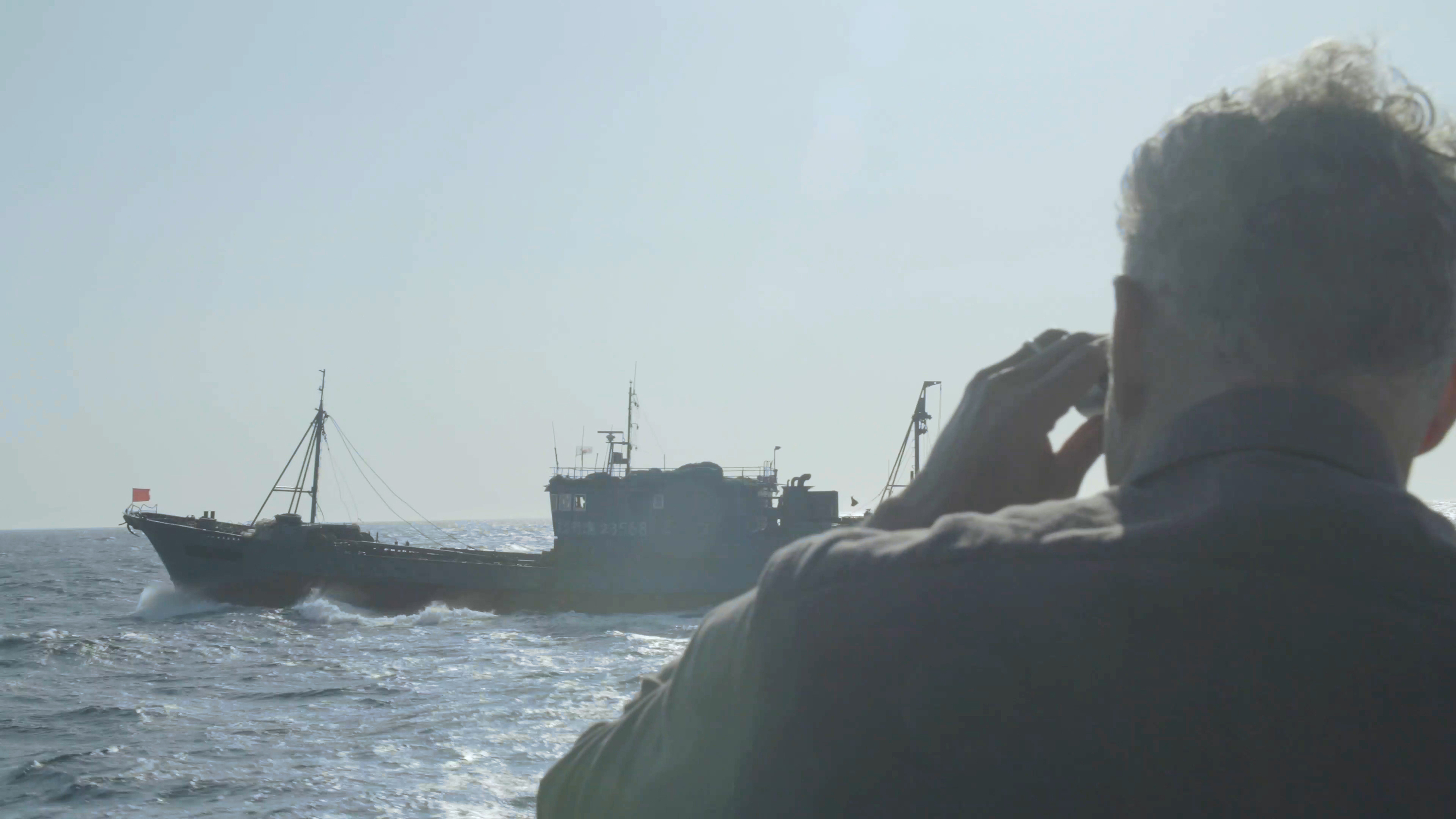
Ian Urbina watches a Chinese vessel through binoculars while at sea in waters between North and South Korea. May 2019 (Photo: The Outlaw Ocean Project/ FábioNascimento)
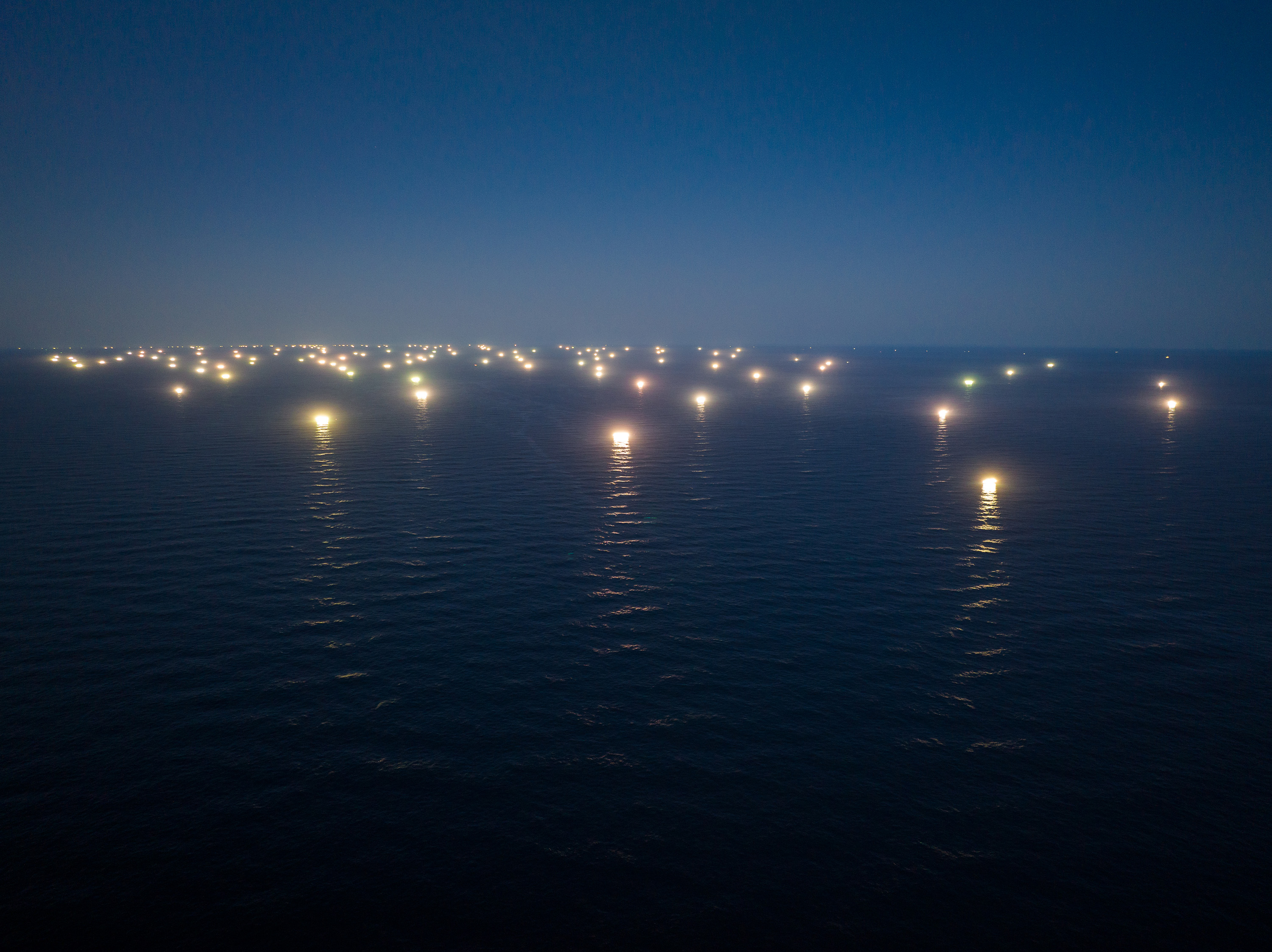
The Chinese squid fleet’s bright lights illuminate the sky at night. 25 February 2022 (Photo: The Outlaw Ocean Project/Ed Ou)
“There is an absolute humanitarian and economic crisis happening off of Uruguay’s shores,” Kenn S George, then the US ambassador to Uruguay, said in 2020 in a speech at a press conference on human rights and illegal fishing. At the time, port records indicated that at least one dead body every other month was being disembarked at the port mostly from Chinese fishing ships.
“There are reports that foreign workers aboard these vessels are subjected to abuses indicative of forced labour, including unpaid wages, confiscated identification, physical abuse and human trafficking.” He called on Uruguay to conduct more inspections of the ships visiting its port.
In an interview in March 2022, Aldo Braida, the president of Cape, a trade association of foreign fishing agents, dismissed reports about the number of dead bodies being disembarked in port. “There are a lot of lies around this,” he said about the death tally, citing “fake news”. He told me that, if crew members suffered physical abuse, Uruguayan authorities would discover it.
In light of how many fishing boats operate in the waters near the Falklands, and considering how few ports they can visit if they have a death, the mortality rate is actually not that high, he contended, adding that if you put men in close quarters for many months, fights are bound to break out. He added: “We live in a violent society.”
On 13 July 2022, roughly 40 miles from shore, on its way towards port on the Galapagos island of Santa Cruz, an ocean-conservation ship called the Modoc was approached by an Ecuadorian Navy vessel. “Stop,” an Ecuadorian Navy officer said over the radio. “You must leave Ecuadorian waters immediately and go to another country.” The officer continued: “If you do not turn around now, we will board and arrest you.”
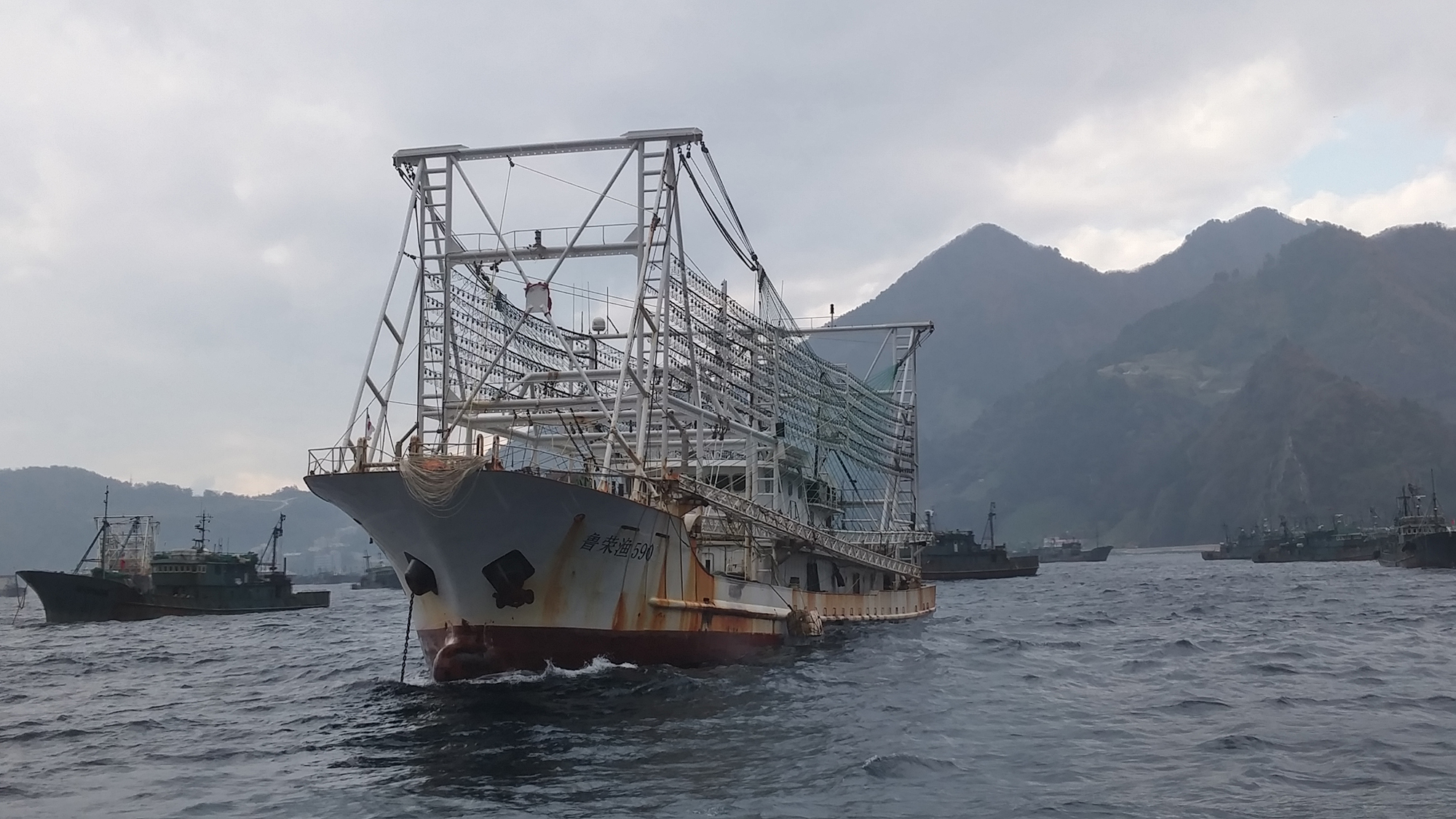
A Chinese ship docked in Ulleung Island, South Korea. May 2019 (Photo: The Outlaw Ocean Project/Fábio Nascimento)
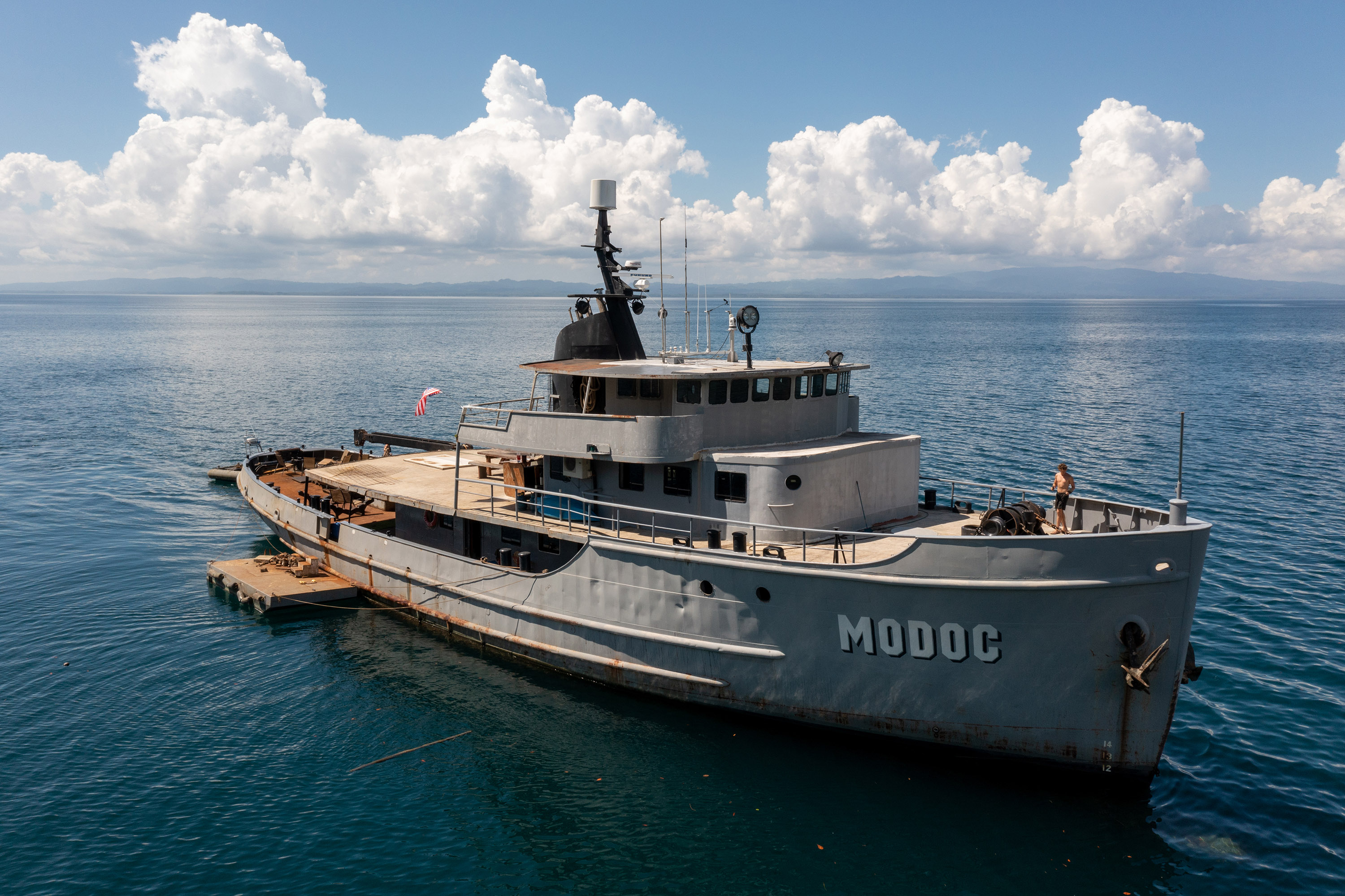
The ocean-conservation ship called the Modoc, which carried reporters to visit Chinese ships, was told to exit Ecuadorian waters on 14 July 2022. 6 February 2022 (Photo: Ben Blankenship/The Outlaw Ocean Project)
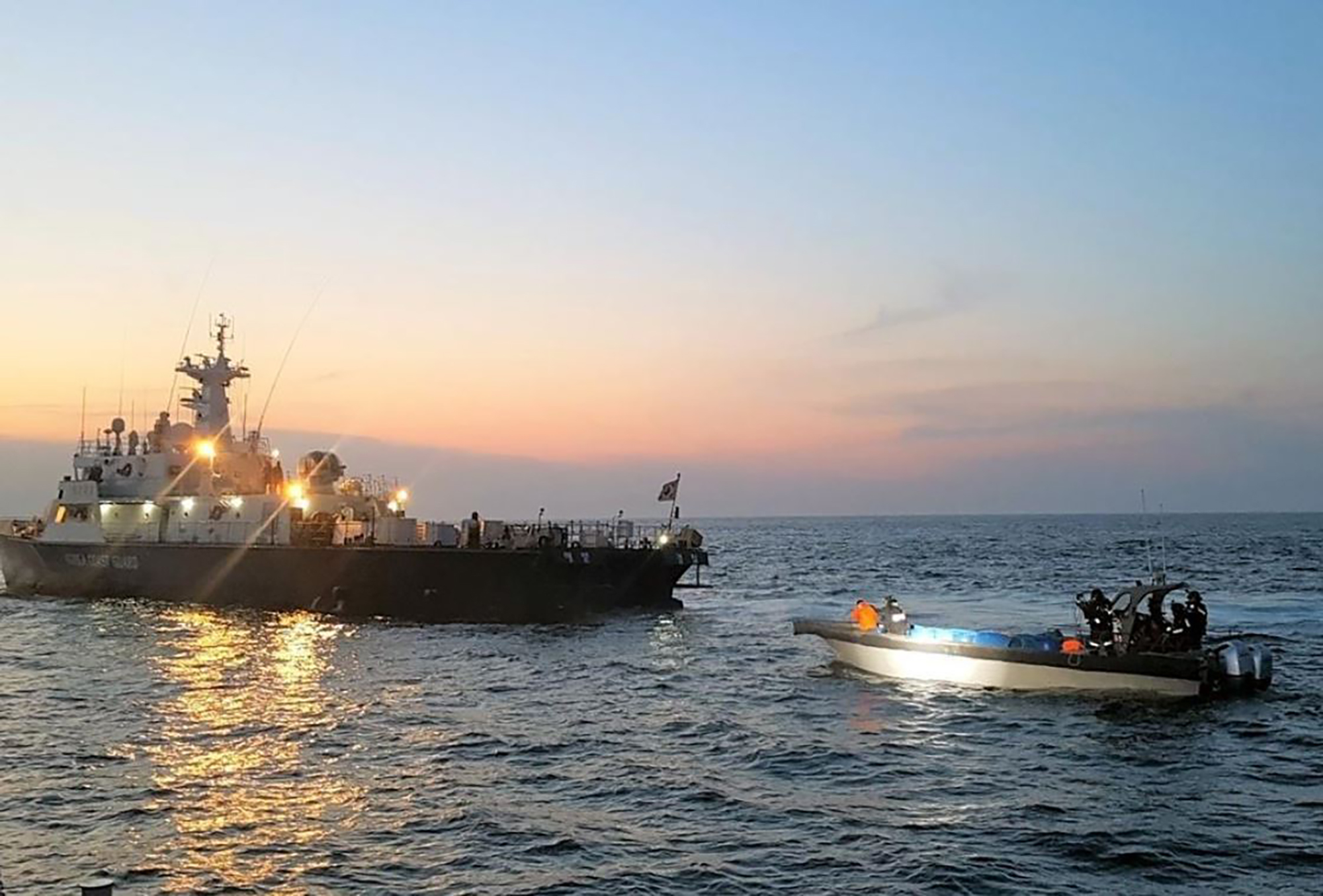
South Korean Coast Guard seizes a Chinese fishing boat for alleged illegal fishing in South Korean waters. 12 June 2022 (Photo: Korean Coast Guard)
The Modoc, which had a journalist and his team on board, halted its approach but held its position, because it lacked enough fuel, water and food to return to the high seas or travel to another country. Twenty-four hours later, armed Ecuadorian authorities boarded the ship and removed the journalists, expelling them from the country and giving the captain 72 hours to stock up and exit Ecuadorian waters.
The incident came as a surprise, because the Modoc, operated by a group called Earthrace, had been given permission to return when it had left from Ecuador for international waters only 10 days earlier. The reason for the change of heart, according to the US ambassador in Ecuador, Michael J Fitzpatrick, was that the Modoc had carried journalists to visit a controversial fleet of Chinese squid ships fishing near Ecuador and Galapagos waters.
During the 10 days before their arrest, the journalists on the Modoc approached dozens of Chinese squid ships, always keeping safe and legal distance and radio-requesting permission to come closer. The goal of the reporting was to observe working conditions on board Chinese ships and to better understand how the squid is caught and tracked on its way to Chinese and foreign buyers.
Some Chinese captains were spooked upon approach and fled. Others were open to talking by radio. None of the Chinese ships shadowed was fishing illegally, though in conversations Chinese officers cited plans to enter Argentinian waters where they are forbidden.
One Chinese captain welcomed several reporters aboard his ship on the condition that he and the vessel were unnamed. The reporters ate instant noodles with the crew, talked to a dozen deckhands, toured the refrigeration area, visited their rooms, and watched the men work. The captain, who stayed on the bridge, was amicable and open. A younger man, presumably his first mate, seemed hesitant and embarrassed. “Please don’t show,” the younger man said to the journalists as they filmed the dirty refrigeration area. “It’s very embarrassing for us.” Before the reporters departed his ship, the captain and crew offered gifts of cigarettes and a bag of squid.
Word soon spread to China and Ecuador that Western journalists were at sea interviewing Chinese squid captains. As the Modoc made its way back to port, a hearing was called by the Ecuadorian National Assembly where legislators questioned the defence minister about the activities of the Modoc and raised concerns about the presence of a US flagged, military-looking vessel from Ecuador.
Read more in Daily Maverick: The Lawless Oceans — forced labour on rust-bucket boats docking at Cape Town harbour
During the hearing, the defence minister said that the Modoc would not be allowed to return to the Galapagos because it had improperly filed transit and other permits. He also cited a deviation in the Modoc’s approved course while exiting national waters, which, he said, had raised suspicions that the vessel was doing scientific research in their waters without permission.
In a subsequent interview, the Ecuadorian foreign minister said that China played no role in the expulsion of the ship and its reporters.
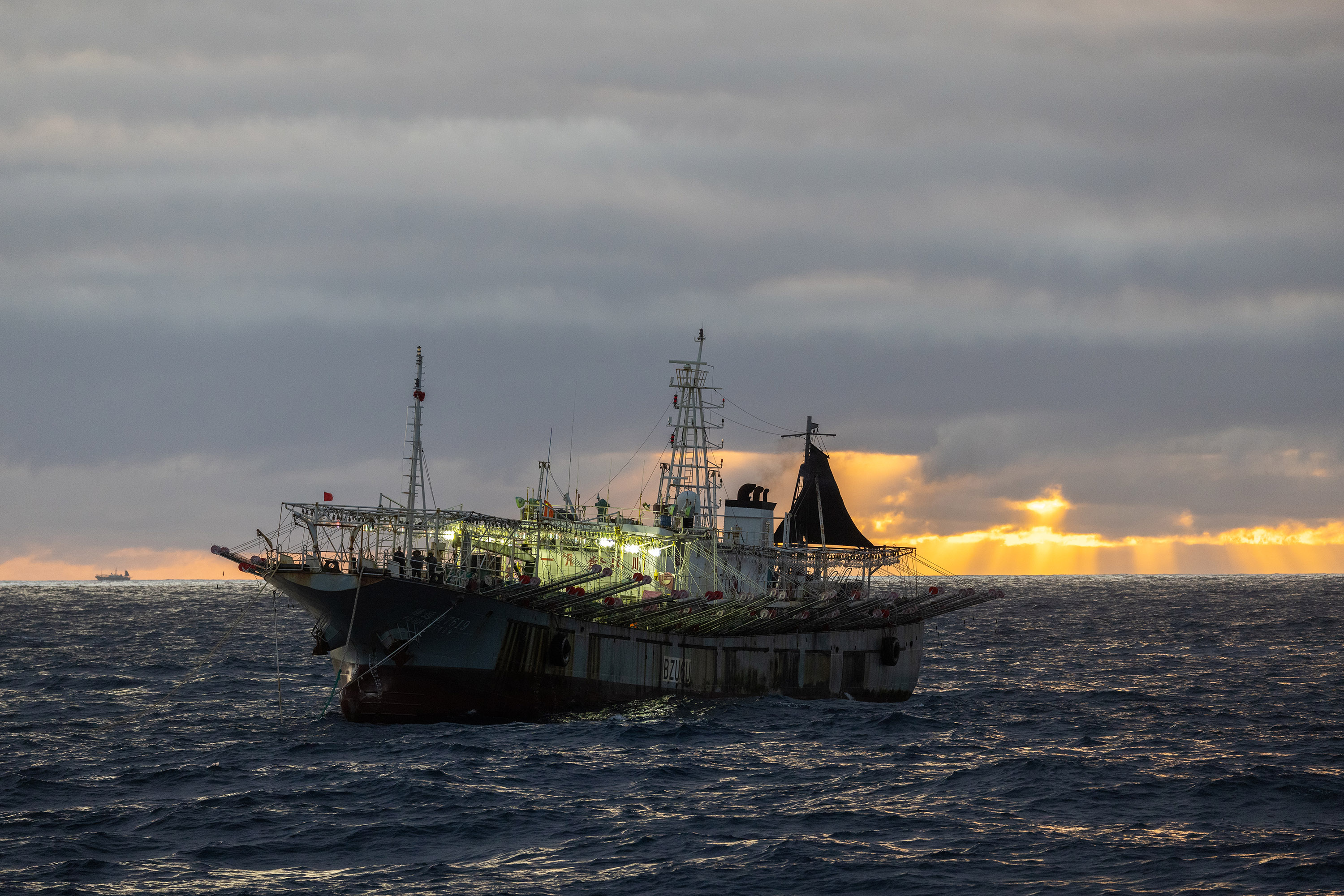
Several South American countries have imposed their own rules on Chinese foreign fleets, but China’s presence in the region is on the rise. 9 July 2022. (Photo: The Outlaw Ocean Project/ Ben Blankenship)
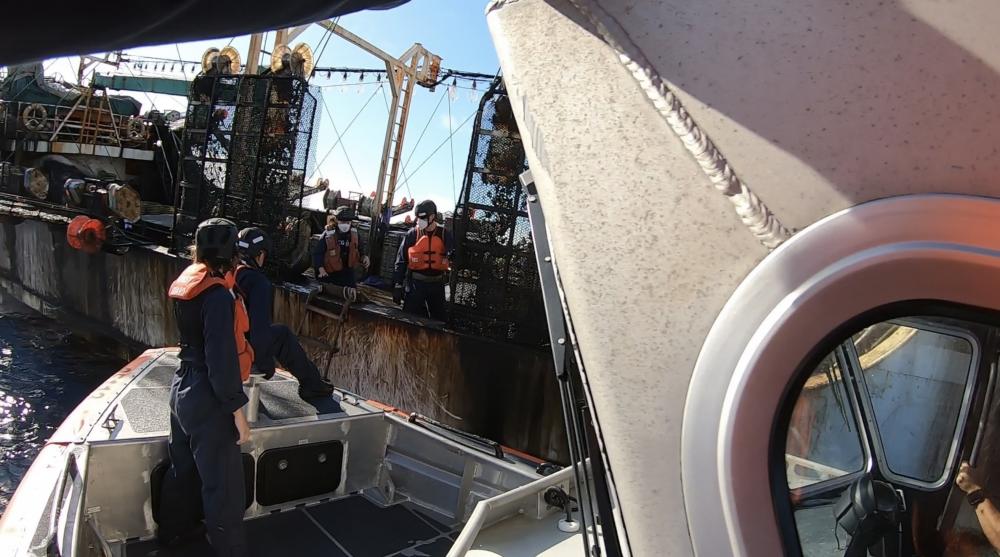
The U.S. Coast Guard prepares to inspect a Chinese squid vessel in the high seas near the Galapagos Islands. 6 August 2022 (Photo: US Coast Guard Petty Officer 3rd Class/ Hunter Schnabel)

Ian Urbina and crew aboard the Modoc, which had been given permission to return to Ecuador when it left the Ecuadorian port for international waters on 4 July 2022. 13 July 2022 (Photo: The Outlaw Ocean Project / Ed Ou)
Ambassador Fitzpatrick, when asked about the situation, did not agree. “These events were political,” he said, “and had everything to do with China.”
For more than a decade, more than 300 Chinese squid ships have visited this squid fishery annually – industrial squid fishing on an unprecedented scale. This, coupled with the fleet’s occasional and alleged incursions into the biodiverse national waters of the Galapagos, had in 2020 spurred a media storm among Western news outlets that was highly unfavourable to the Chinese. “China did not want more media attention,” Fitzpatrick said, explaining why the Modoc had been ordered out of Ecuadorian waters. “So they asked the Ecuadorians to help.”
And the Ecuadorians – whose national debt to China amounts to more than 10% of its entire GDP – obliged. DM
This story was produced by The Outlaw Ocean Project, a nonprofit journalism organisation in Washington, D.C. Reporting and writing was contributed by Ian Urbina, Joe Galvin, Maya Martin, Susan Ryan, Daniel Murphy and Austin Brush. This reporting was partially supported by the Pulitzer Center.



















 Become an Insider
Become an Insider
Comments - Please login in order to comment.